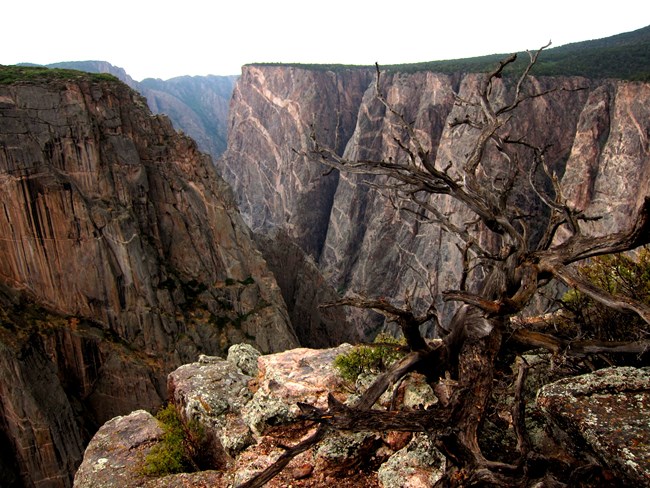
NPS/A. Washuta
The Northern Colorado Plateau Network monitors air quality, big rivers, climate, invasive exotic plants, land surface phenology, landbirds, landscape dynamics, uplands, and water quality at Black Canyon of the Gunnison National Park. The results of that monitoring provide park managers with scientific information for decisionmaking.
Before becoming a national park in 1999, Black Canyon of the Gunnison National Park was established as Black Canyon of the Gunnison National Monument by Presidential Proclamation on March 2, 1933, for "preservation of the spectacular gorges and additional features of scenic, scientific, and educational interest." The walls of the Black Canyon rise at least 2,000 feet above the Gunnison River, which roars in the canyon depths at an average gradient of 95 feet per mile in the park.
Elevation ranges from 1,645 meters (5,400 feet) at canyon bottom to 2,675 meters (8,775 feet) on Signal Hill. Temperatures range from a low of -9°C (15°F) in the winter to approximately 29°C (85°F) in the summer. Average annual precipitation is 400–508 millimeters (16–20 inches). Snowfall measures between 76 and 140 centimeters (30–55 inches). Most precipitation occurs in the form of spring and summer rains. The canyon rims are dominated by scrub oak and pinyon-juniper forests intermixed with patches of high-desert sagebrush communities. The canyon's north-facing slopes favor Douglas-fir and Colorado blue spruce, while the river bottom has a number of deciduous trees and shrubs characteristic of river strands in the region.
Livestock grazing, exotic plant species invasion, adjacent land development, an altered hydrologic regime, past fire exclusion, and a lack of baseline data are the park's main natural resource management concerns.
Quick Reads
Publications
Source: NPS DataStore Saved Search 3759. To search for additional information, visit the NPS DataStore.
Source: NPS DataStore Saved Search 3760. To search for additional information, visit the NPS DataStore.
Last updated: October 31, 2020
